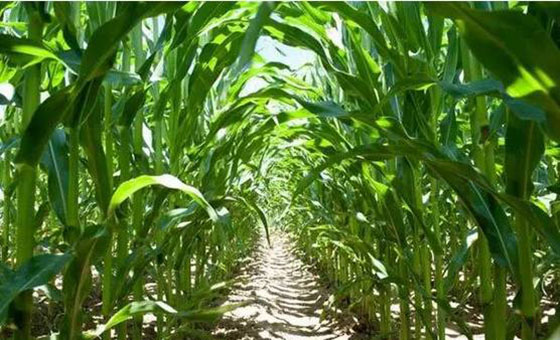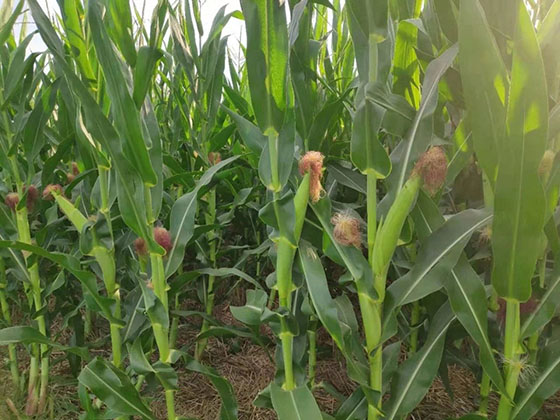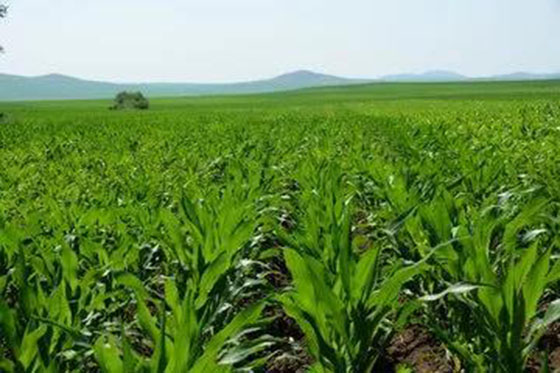How to plant corn this year? How to fertilize?
VIEWS: times Release Date:2021-04-02
One. Characteristics of corn fertilizer requirement

1. The nutrient requirements of corn in different growth periods
The ratio of nutrients required by corn during each growth period is different. From seedling to jointing, corn absorbs 2.5% nitrogen, 1.12% available phosphorus, and 3% available potassium; from jointing to flowering, it absorbs 51.15% nitrogen, 63.81% available phosphorus, and 97% available potassium; from flowering to maturity, it absorbs 46.35 nitrogen. %, available phosphorus 35.07%, available potassium 0%.
The critical period of corn nutrition:
The critical period of phosphorus nutrition in maize is the three-leaf period, which is generally the period when seed nutrition turns to soil nutrition; the critical period of nitrogen in maize is later than phosphorus, usually when vegetative growth turns to reproductive growth. The critical period does not require much nutrient, but the nutrient must be comprehensive and the ratio must be appropriate. Too much, too little or unbalanced nutrient elements during this period will have obvious adverse effects on the growth and development of corn, and no matter how to supplement the lack of nutrient elements in the future, it will not help.
Maximum efficiency period of corn nutrition:
The maximum efficiency period of maize is in the large bell mouth period. This is the fastest and largest period of nutrient absorption by corn. During this period, the absolute and relative amounts of nutrients required by corn are the largest, the absorption rate is also the fastest, and the effect of fertilizer is the largest. At this time, the fertilizer application amount is appropriate, and the yield increase effect of corn is the most obvious.
2. The nutrient requirements of corn throughout the growth period
The growth of maize needs to absorb a variety of mineral nutrients from the soil, of which nitrogen is the most, potassium is the second, and phosphorus is the third.
Generally, every 100 kilograms of grains produced requires 2.5 kilograms of pure nitrogen, 1.2 kilograms of phosphorus pentoxide, and 2.0 kilograms of potassium oxide from the soil. The ratio of nitrogen, phosphorus and potassium is 1:0.48:0.8.
Fertilizer application amount = (Planned output required for a certain element-soil supply for a certain element) / (a certain element content in fertilizer (%) × fertilizer utilization rate (%)), the utilization rate of fertilizer varies greatly. According to experiments, the general utilization rate of organic farm manure in the current season is about 30%, the utilization rate of nitrogen fertilizer in the current season is about 40%-50% (calculated as 40%), and the utilization rate of phosphorus and potassium fertilizer is about 30%-40% (in terms of 30%).
Q. How much fertilizer is required to produce 500 kg of corn kernels per mu? Assuming that the soil nitrogen content per mu during the soil census is 17 kilograms, phosphorus pentoxide is 6.0 kilograms, and potassium oxide is 14.4 kilograms. The nutrient utilization rate in the soil is 50% nitrogen, 70% phosphorus pentoxide, and 30% potassium oxide. When the national fertilizer test averages 500 kg per mu, 2.9 kg nitrogen, 1.2 kg phosphorus, and 2.4 kg potassium are required for every 100 kg of grain produced. Calculate the application amount of urea, superphosphate and potassium chloride (urea contains 46% of available nitrogen, Superphosphate contains 16% of available phosphorus, and potassium chloride contains 50% of available potassium).
Second, the amount of corn fertilizer

1. Determine the target output
The target yield is the amount of corn to be planted that year. It is determined by the soil fertility of the cultivated land. In addition, the target yield of corn can be increased by 10%-15% based on the average yield of corn in the first 3 years of the plot. For example: a certain plot of soil with high fertility, the planned corn output that year reached 600 kilograms, the nitrogen, phosphorus, and potassium nutrients required for the entire growth period of corn are 15 kilograms, 7.2 kilograms and 12 kilograms, respectively.
2. Calculate the supply of soil nutrients
Determine how many available nutrients are contained in the soil, and then calculate how many nutrients are contained in 1 acre of land. 1 mu of surface soil is calculated as 20 cm, and there are 150,000 kg of soil. If the measured value of soil alkaline hydrolyzed nitrogen is 120 mg/kg, the measured value of available phosphorus content is 40 mg/kg, and the measured value of available potassium content is 90 mg/kg. , The total amount of available alkali hydrolyzable nitrogen in 1 mu of soil is: 150,000 kg × 120 mg/kg × 10 minus 6 power = 18 kg, the total available phosphorus is 6 kg, and the total available potassium is 13.5 kg.
Since many factors in the soil affect the availability of soil nutrients, all the effective nutrients in the soil cannot be absorbed and utilized by corn, and a soil nutrient correction coefficient needs to be multiplied. Studies on the parameters of formula fertilization in various provinces in my country have shown that the correction coefficient for alkali hydrolyzed nitrogen is between 0.3 and 0.7, the correction coefficient for effective phosphorus is between 0.4 and 0.5, and the correction coefficient for available potassium is between 0.5 and 0.85.
The utilization rate of nitrogen, phosphorus and potassium fertilizers is: nitrogen 30%-35%, phosphorus 10%-20%, potassium 40%-50%.
3. Determine the amount of corn fertilizer
With the amount of nutrients required for the whole growth period of corn, the supply of soil nutrients and the fertilizer utilization rate, the amount of fertilizer applied to corn can be directly calculated. Then the pure nutrient content is converted into the actual amount of fertilizer, which can be used to guide fertilization. According to the data in 1 and 2, the pure nitrogen required for a yield of 600 kg of corn per mu is (15-18×0.6) ÷ 0.30 = 14 kg. The amount of phosphorus is (7.2-6×0.5) ÷ 0.2=21 kg. Considering the obvious aftereffect of phosphate fertilizer, the application of phosphate fertilizer can be reduced by half, that is, 10 kg. The amount of potassium is (12-13.5×0.6) ÷ 0.50=8 kg. If diammonium phosphate, urea and potassium chloride are used, 20kg-22kg of diammonium phosphate, 22kg-25kg of urea and 14kg of potassium should be applied per mu.
4. Application of micro-fertilizer
Corn is very sensitive to zinc. If the effective zinc in the soil is less than 0.5 mg/kg-1.0 mg/kg, zinc fertilizer is needed. The availability of zinc in soil is higher under acidic conditions than alkaline conditions, so now alkaline and calcareous soils are prone to zinc deficiency. In areas where phosphate fertilizer is applied for a long time, due to the antagonistic effect of phosphorus and zinc, it is easy to induce zinc deficiency and should be supplemented. Commonly used zinc fertilizers are zinc sulfate and zinc chloride. The amount of base fertilizer per mu is 0.5 kg-2.5 kg, the seed dressing is 4 g/kg-5 g/kg, and the seed soaking concentration is 0.02%-0.05%. If the compound fertilizer contains a certain amount of zinc, it is not necessary to apply zinc fertilizer separately.
Three, corn fertilization method

1. Base fertilizer
2000kg-3000kg organic fertilizer, all phosphate fertilizer, 1/3 nitrogen fertilizer, and all potash fertilizer are used as base fertilizer or seed fertilizer. It can be combined with plowing and ridging to be applied into the sowing ditch at one time, so that the fertilizer can be applied to the cultivated layer of 10 cm-15 cm. All chemical fertilizers can be used as base fertilizer.
2. Seed fertilizer
Seed fertilizer is the most economical and effective method of fertilization. There are many ways to apply seed fertilizer, such as: seed dressing, seed soaking, strip application, and hole application. Seed dressing can choose humic acid, biological fertilizer and micro-fertilizer, dissolve the fertilizer, spray it on the corn seeds, and mix while spraying, so that the fertilizer solution is evenly covered on the surface of the seeds, and the seeds are sowed after being dried in the shade.
Seed soaking: Dissolve the fertilizer to a certain concentration, soak the seeds in the solution for 12 hours, and sow immediately after drying in the shade.
Strip application and hole application: The fertilizer is suitable for strip application and hole application. The amount of fertilizer used for seed fertilizer is 2 kg-5 kg. However, the fertilizer must be separated from the seeds; deep fertilization is better, and the appropriate depth is 10 cm-15 cm. Urea, ammonium bicarbonate, ammonium chloride, and potassium chloride are not suitable for seed fertilizer.
3. Top dressing
The remaining 2/3 nitrogen fertilizer is used as top dressing. Top dressing is divided into four top dressing periods: seedling fertilizer, stalk fertilizer, ear fertilizer and grain fertilizer, and the following two periods are the focus:
Stalk fertilizer: topdressing within 10 days after jointing, can promote stem growth and promote the differentiation of young ears. Use 1/3 of the nitrogen fertilizer in the top dressing as jointing fertilizer, combined with shoveling, the distance between the fertilizer and the seedling is 5 cm-7 cm.
Ear fertilizer: The remaining nitrogen fertilizer is applied at the big bell mouth period of 10 days-15 days before tasseling of corn, which can promote the ears and more grains, and the effect of grain filling is good in the later stage.
Previous : Huaqiang Chemical's special water-soluble fertilizer for Meinongba pepper was successfully put into the market
Next : Rapeseed Fruit Growth and Fertilization Management
Latest News
- The company overcame difficulties and won a "good start" in the first quarter ...2022-03-28
- Safe Production ...2022-03-28
- first-line collection ...2022-03-26
- Huaqiang News ...2022-03-26
- Huaqiang Chemical Strong Agriculture Project ...2022-03-25
- huaqiang news ...2022-03-24
- winning unit ...2022-03-22
- Huaqiang News ...2022-03-21
Related Information
- 2,200 tons of NPK 23-10-5+6s+1zn fertilizer sent to Africa ...2021-01-03
- The best fertilizers for fruits and crops ...2020-05-26
- Humic Acid Fertilizer ...2019-12-31
- Bulk Blending Fertilizer ...2019-12-27
- Water Soluble Fertilizer ...2019-12-08
- NPK Fertilizer ...2019-12-02
- Potassium Sulfate Fertilizer ...2019-11-30
- Urea Fertilizer ...2019-11-21
MESSAGE
Our sales staff will be the first time to get in touch with you,to provide you with the latest price.
-
Chemical Products
-
Compound fertilizer
-
Contact Us
Huaqiang Chemical Group Stock Co.,Ltd.
No.1 Jinping Avenue, Dangyang , Hubei , China
Http://www.hq-chemical.com
info@hq-chemical.com
Tel:+86 717 3431866
Mobile: +86 18627120543
© Copyright 2021 Huaqiang Chemical Group Stock Co.,Ltd. All Rights Reserved



